Electric Guitar Multimedia |
|

|
Listen to "In El Rancho Grande" recorded by Milton Brown and his Brownies in the 1930s, featuring the band's signature lap steel slide electric guitar sound.
From The Legacy, the True and the Untamed (MCA Nashville MCA3P-2771) |

|
Listen to "Solo Flight," a swing tune by Benny Goodman and his orchestra featuring electric guitar pioneer Charlie Christian leading the band with a solo.
From Swing That Music! (Sony-Smithsonian Collection of Recordings RD 102-2) |

|
Listen to "Pacific Breeze," an original composition by Les Paul that pays homage to the pioneering Hawaiian musicians who first recorded electric guitar music.
From Lovers' Luau (Sony A 8086) |

|
Listen to Jimi Hendrix play "The Star Spangled Banner" at the Woodstock music festival in 1969 -- a performance still considered by many to be a perfect example of how the electric guitar revolutionized popular music.
From Woodstock: Three Days of Peace & Music (Atlantic) |
 |
The Electric Guitar
|
Aug. 12, 2002 -- Until about 70 years ago, musical instruments remained pretty much the same as they were for centuries. Then a new invention changed modern music and popular culture as well -- the electric guitar.
For our continuing series Present at the Creation, NPR's Christopher Joyce traces the humble origins of a musical novelty that would eventually shape the sound of rock 'n' roll, and define a "counterculture." But as Joyce discovered, the icon of the rock 'n' roll lifestyle had some humble beginnings.
In the 1930s, American bands got their "swing" from the drums, the bass and the strum of an acoustic guitar. Trouble was, no one could hear the guitar very well, and it pretty much stayed in the background as a rhythm instrument.
"Then something new appeared on bandstands -- a musician sitting on a chair with something that looked like a miniature banjo in his lap," Joyce reports. "A wire connected the instrument to a box. And out came a strange new sound."
That new sound was simple physics. A vibrating metal object -- in this case, a guitar string -- moving in a magnetic field creates a signal that can be picked up by a wire coil. Inventor and musician George Beauchamp, who played Hawaiian music in Los Angeles, is said to have created the first crude electric guitar on his dining room table.
Why was Hawaiian music key to the invention of the electric guitar? "You had the Hawaiian musicians where... the guitar was the melody instrument," says guitar historian Richard Smith. "So the real push to make the guitar electric came from the Hawaiian musicians."
Beauchamp applied for a patent for his invention -- a small guitar body with two horseshoe magnets on the top, with the strings running between the magnets' arms. Beauchamp dubbed the instrument the "frying pan." In 1931, he and engineer Adolph Rickenbacker created their first electric guitar. But Beauchamp didn't get a patent until 1937, and by then several other companies were making their own electric guitars.
The selling point to musicians was volume. For the first time, a guitar could hold its own against the horn section, and guitarists could pick out melody lines instead of just strumming the rhythm. In the late 1930s, guitar pioneers Floyd Smith and Charlie Christian brought the electric guitar into the jazz world, and redefined the role of the guitar in the swing orchestra ensemble.
There were a few technical headaches with the earliest models. Western swing music leaders such as Milton Brown liked the Spanish-style, hollow-body electrics. These looked like real guitars and less like frying pans -- but the sound resonating in the guitar body often created a harsh feedback loop. Musicians often stuffed rags and newspapers into their guitars to eliminate the problem.
The permanent solution was a solid-body guitar. With electric pickups, a guitarist didn't need a big, hollow body to resonate and project sound. Companies had built solid-body guitars since the 1930s, but another guitar pioneer, Les Paul, took this concept to its logical extreme.
Paul built his own guitar, using telephone parts for a pickup and a wood post as the body. He called it "the log," and he says that when he first played it in a New York City night club, the audience didn't know what to think. "You come in with a four-by-four, people look at you like you're freaked out," he says. Paul went home, cut the body off a Spanish-style guitar and glued it to his log -- "and it went over great."
Electric guitars had volume, but it would take a second wave of innovation to turn the instruments into the icons of a new generation of music. In 1943, California radio repairman Leo Fender and musician Doc Kaufman built a prototype solid-body guitar that was a lot like the original "frying pan," but with a better pickup and tone controls.
But most importantly, says Smith, it was relatively cheap. Suppliers provided parts for production on an assembly line. It was a guitar for the masses.
By 1950, the Fender company was pumping out copies of the Esquire, then the Broadcaster, and then the Telecaster. In 1952, Gibson -- until then the nation's biggest guitar company -- introduced its own solid-body guitar, the Les Paul.
The tools of the revolution were now in the hands of America's youth, and popular music and culture would never be the same.
Other Resources
• Learn more about the evolution of the solid-body electric guitar and bass guitar at the Web site for Seattle's Experience Music Project.
• The Lemelson Center at the Smithsonian Institution National Museum of American History features a Web history of the electric guitar.
• Fender Musical Instruments Corporation
• Rickenbacker International Corporation
• A history of the guitar from the Library of Congress.
• A biography of jazz guitar pioneer Charlie Christian can be found at Classic Jazz Guitar.com.
For our continuing series Present at the Creation, NPR's Christopher Joyce traces the humble origins of a musical novelty that would eventually shape the sound of rock 'n' roll, and define a "counterculture." But as Joyce discovered, the icon of the rock 'n' roll lifestyle had some humble beginnings.
In the 1930s, American bands got their "swing" from the drums, the bass and the strum of an acoustic guitar. Trouble was, no one could hear the guitar very well, and it pretty much stayed in the background as a rhythm instrument.
"Then something new appeared on bandstands -- a musician sitting on a chair with something that looked like a miniature banjo in his lap," Joyce reports. "A wire connected the instrument to a box. And out came a strange new sound."
That new sound was simple physics. A vibrating metal object -- in this case, a guitar string -- moving in a magnetic field creates a signal that can be picked up by a wire coil. Inventor and musician George Beauchamp, who played Hawaiian music in Los Angeles, is said to have created the first crude electric guitar on his dining room table.
Why was Hawaiian music key to the invention of the electric guitar? "You had the Hawaiian musicians where... the guitar was the melody instrument," says guitar historian Richard Smith. "So the real push to make the guitar electric came from the Hawaiian musicians."
Beauchamp applied for a patent for his invention -- a small guitar body with two horseshoe magnets on the top, with the strings running between the magnets' arms. Beauchamp dubbed the instrument the "frying pan." In 1931, he and engineer Adolph Rickenbacker created their first electric guitar. But Beauchamp didn't get a patent until 1937, and by then several other companies were making their own electric guitars.
The selling point to musicians was volume. For the first time, a guitar could hold its own against the horn section, and guitarists could pick out melody lines instead of just strumming the rhythm. In the late 1930s, guitar pioneers Floyd Smith and Charlie Christian brought the electric guitar into the jazz world, and redefined the role of the guitar in the swing orchestra ensemble.
There were a few technical headaches with the earliest models. Western swing music leaders such as Milton Brown liked the Spanish-style, hollow-body electrics. These looked like real guitars and less like frying pans -- but the sound resonating in the guitar body often created a harsh feedback loop. Musicians often stuffed rags and newspapers into their guitars to eliminate the problem.
The permanent solution was a solid-body guitar. With electric pickups, a guitarist didn't need a big, hollow body to resonate and project sound. Companies had built solid-body guitars since the 1930s, but another guitar pioneer, Les Paul, took this concept to its logical extreme.
Paul built his own guitar, using telephone parts for a pickup and a wood post as the body. He called it "the log," and he says that when he first played it in a New York City night club, the audience didn't know what to think. "You come in with a four-by-four, people look at you like you're freaked out," he says. Paul went home, cut the body off a Spanish-style guitar and glued it to his log -- "and it went over great."
Electric guitars had volume, but it would take a second wave of innovation to turn the instruments into the icons of a new generation of music. In 1943, California radio repairman Leo Fender and musician Doc Kaufman built a prototype solid-body guitar that was a lot like the original "frying pan," but with a better pickup and tone controls.
But most importantly, says Smith, it was relatively cheap. Suppliers provided parts for production on an assembly line. It was a guitar for the masses.
By 1950, the Fender company was pumping out copies of the Esquire, then the Broadcaster, and then the Telecaster. In 1952, Gibson -- until then the nation's biggest guitar company -- introduced its own solid-body guitar, the Les Paul.
The tools of the revolution were now in the hands of America's youth, and popular music and culture would never be the same.
Other Resources
• Learn more about the evolution of the solid-body electric guitar and bass guitar at the Web site for Seattle's Experience Music Project.
• The Lemelson Center at the Smithsonian Institution National Museum of American History features a Web history of the electric guitar.
• Fender Musical Instruments Corporation
• Rickenbacker International Corporation
• A history of the guitar from the Library of Congress.
• A biography of jazz guitar pioneer Charlie Christian can be found at Classic Jazz Guitar.com.

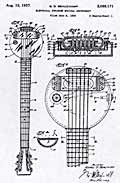
Illustration for the 1937 patent application for the Rickenbacker "frying pan" electric guitar.
Photo courtesy the Smithsonian National Museum of American History -- The Lemelson Center
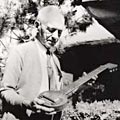
In this 1972 photo, Adolph Rickenbacker holds the original prototype of the "frying pan" electric guitar.
Photo copyright 1997 Rickenbacker International Corporation, all rights reserved
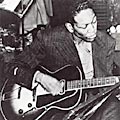
Electric guitar pioneer Charlie Christian helped re-define the role of the guitar player in the swing band ensemble.
Photo courtesy the Smithsonian National Museum of American History -- The Lemelson Center
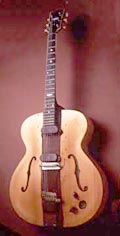
The original Les Paul "log" electric guitar, with two halves of a Spanish hollow-body guitar glued to a wooden four-by-four post.
Photo courtesy the Smithsonian National Museum of American History -- The Lemelson Center
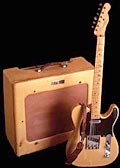
The Fender Telecaster (pictured here with amplifier) was first produced in 1952 and is still one of Fender's best-selling electric guitar models.
Photo courtesy Fender Musical Instruments Corporation
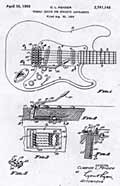
Illustration from the 1954 patent application for the Fender Stratocaster, a model popularized by guitar legends such as Jimi Hendrix and Eric Clapton.
Photo courtesy the Smithsonian National Museum of American History -- The Lemelson Center